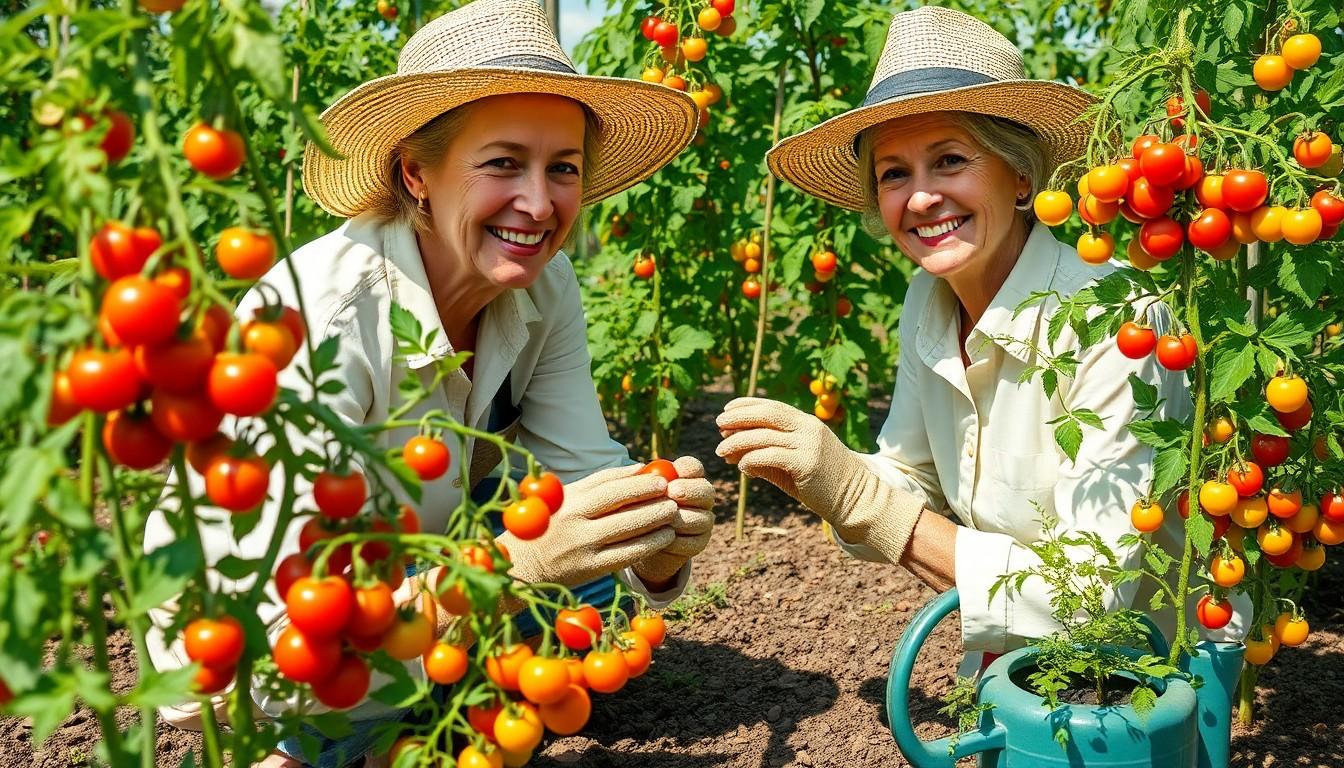Growing cherry tomatoes can feel like hosting a party in your garden even with plant maintenance. These bite-sized beauties are not just delicious; they’re the life of the vegetable patch. But just like any good guest, they need a little TLC to truly shine. If you want to avoid the heartbreak of wilted leaves and sad little fruits, it’s time to roll up those sleeves and dive into the world of cherry tomato plant care.
Cherry Tomato Plant Care
Cherry tomato plants thrive with the right care and attention. Proper watering techniques ensure healthy growth. Watering at the base of the plant prevents foliage diseases while keeping soil consistently moist, yet not waterlogged. Fertilizing every four to six weeks with a balanced fertilizer supports robust development and fruit production.
Sunlight plays a critical role in the health of cherry tomato plants. They require six to eight hours of direct sunlight daily. Adequate exposure enhances photosynthesis and encourages fruitful harvests.
Pruning is vital for maintaining plant structure. It helps improve air circulation and sunlight penetration throughout the plant. Removing suckers—growth that develops between the main stem and branches—promotes larger fruit sizes and better yields.
Pest management is essential in cherry tomato care. Common pests include aphids and spider mites. Regular inspection allows for early detection and treatment with natural insecticides like neem oil. Diseases like blight can also affect growth; planting resistant varieties reduces this risk.
Supporting the plants enhances overall fruit quality. Providing stakes or cages offers physical support, helping prevent branches from breaking under the weight of the fruit. Support structures also improve airflow, further reducing disease risk.
Harvesting cherry tomatoes at the right time maximizes flavor. Fruits should be picked while still firm but slightly soft to the touch. Harvesting in the morning yields the best taste due to heightened sugar levels.
Following these care tips ensures healthy, productive cherry tomato plants, leading to bountiful harvests and vibrant garden displays.
Choosing the Right Variety
Selecting the right cherry tomato variety significantly affects growth and fruit production. Several options cater to different gardening needs and climates.
Determinate vs. Indeterminate
Determinate plants grow to a specific height and produce fruit in a concentrated period. This type facilitates easier harvesting and typically requires less support. Indeterminate plants, however, continue to grow and produce fruit throughout the growing season. They provide a continuous harvest, offering more flexibility but necessitating additional support structures.
Popular Cherry Tomato Varieties
Several popular cherry tomato varieties are available. ‘Sweet 100’ boasts abundant, small, sweet fruits ideal for snacking. Another favorite, ‘Sun Gold,’ delivers bright orange, sweet tomatoes rich in flavor. ‘Black Cherry’ stands out with its unique dark color and rich taste. ‘Yellow Pear’ captivates gardeners with its whimsical shape and mild flavor. Choosing the right variety enhances the cherry tomato growing experience and contributes to a fruitful harvest.
Planting Cherry Tomatoes
Proper planting ensures healthy cherry tomato growth. Choosing the right conditions sets the stage for a successful harvest.
Ideal Soil Conditions
Cherry tomatoes thrive in well-draining soil rich in organic matter. Consider using a soil mix with a pH between 6.0 and 6.8 to promote nutrient uptake. They benefit from added compost or well-rotted manure, enhancing soil fertility. Mulch can retain moisture and suppress weeds, which also contributes to a healthier plant environment. Avoid compacted soil, which can hinder root growth. Aeration improves drainage and is key for vibrant plants.
Optimal Planting Time
Timing plays a crucial role in planting cherry tomatoes. Generally, planting occurs after the last frost date in spring, ensuring warm soil for seedling establishment. Transplant seedlings outdoors when they reach 6-8 inches tall, typically 2-3 weeks after the last frost. Check local climate trends for specific dates. Regions with longer growing seasons can support earlier planting, promoting better yields. Late summer planting may extend the harvest into fall, giving plants more time to produce tasty fruits.
Watering and Fertilizing
Proper watering and fertilizing promote healthy cherry tomato plants. Both practices significantly contribute to vibrant fruit production.
Watering Strategies
Watering at the base of the plant prevents fungal diseases and ensures moisture reaches the roots. Consistent soil moisture is crucial; irregular watering leads to blossom end rot. During peak growing seasons, aim for watering 1 to 1.5 inches per week, adjusting based on rainfall. Early morning is the best time for watering, as it allows plants to absorb moisture without excessive evaporation. Always check the soil moisture level; it should feel slightly damp but not soggy.
Fertilization Techniques
Fertilizing cherry tomatoes enhances their growth and fruit quality. Start with a balanced fertilizer, like a 10-10-10 NPK, at transplanting time. Following the initial application, switch to a fertilizer with higher potassium levels, such as 5-10-10, about three to four weeks after planting to support fruit development. Apply fertilizer every four to six weeks, depending on the growth stage of the plant. Always water the plants after fertilizing to help nutrients penetrate the soil. Using organic options like compost or fish emulsion also boosts soil health while promoting plant vigor.
Pest and Disease Management
Proper management of pests and diseases ensures healthy cherry tomato plants and robust harvests. Awareness and timely action prevent significant damage.
Common Pests
Aphids often attack cherry tomato plants, sucking sap and weakening the plant. Spider mites introduce webs and cause leaf discoloration. Other pests like whiteflies and hornworms can also pose threats. Insects can be managed by regularly inspecting plants and using insecticidal soap or neem oil for treatment. Establishing barriers such as row covers protects young plants from pests. Encouraging beneficial insects like ladybugs further aids in natural pest control.
Preventing Diseases
Fungal diseases can impact cherry tomatoes significantly if not addressed. Maintaining adequate air circulation, through pruning and spacing, reduces humidity levels around plants. Utilizing disease-resistant varieties can mitigate risks of common issues like blight. Crop rotation every few years ensures that soil pathogens do not build up. Watering at the base of plants prevents moisture buildup on leaves, reducing the chances of fungal infections. Regularly monitoring for early signs of disease enables swift intervention, preserving plant health.
Pruning and Supporting Plants
Pruning and supporting cherry tomato plants significantly impacts their growth and productivity. Both practices enhance air circulation and reduce disease risk.
Pruning Techniques
Pruning involves removing suckers, which are small shoots that develop in the leaf axils. This practice encourages larger fruit production and stronger stems. Regularly trimming excess foliage helps improve airflow, reducing the chance of fungal infections. Timing plays a role; pruning should take place early in the season and every few weeks thereafter. Maintaining a manageable plant height also eases harvesting efforts. In summary, effective pruning fosters healthy plants that yield abundant fruits.
Support Structures
Providing support structures is essential for cherry tomato plants. Staking or using cages prevents branches from breaking under the weight of the fruit. Using 5 to 6-foot stakes allows plants to grow vertically, optimizing space and sunlight exposure. When using cages, opt for those made of sturdy materials to withstand strong winds. Positioning support structures at planting time avoids damaging roots later. Implementing these support methods contributes to healthier, more productive plants.
Harvesting Cherry Tomatoes
Harvesting cherry tomatoes at the right time ensures maximum flavor. Observing the fruits closely reveals when they’re ready for picking.
Signs of Ripeness
Ripeness in cherry tomatoes becomes evident through several key indicators. A vibrant color signals that they’re ready for harvest. When tomatoes feel firm yet slightly soft to the touch, they’ve reached optimal maturity. The overall size also matters; typical cherry tomatoes should measure about 1 to 2 inches in diameter. Glossy skin indicates freshness, while dull-looking fruits signify overripeness. Notably, a slight give when gently squeezed further confirms ripeness. Finally, tomatoes that easily detach from the vine often indicate they’re ripe.
Best Practices for Harvesting
Harvesting cherry tomatoes involves specific best practices to maintain quality. Firstly, using pruning shears or scissors helps avoid damaging the plant. Picking tomatoes in the morning results in better flavor and texture. Gently twisting the fruit or cutting it from the stem minimizes bruise risk. Aim to harvest tomatoes that display a consistent color throughout. Collecting them in a shallow container prevents squashing during transport. Storing freshly harvested tomatoes at room temperature enhances their taste. Lastly, avoid refrigerating cherry tomatoes to preserve their flavor and texture.
Vibrant Display of Color and Flavor
Caring for cherry tomato plants can transform any garden into a vibrant display of color and flavor. By following the outlined practices for watering, fertilizing, and pest management, gardeners can ensure their plants thrive. Choosing the right variety and providing proper support will lead to abundant harvests.
With attention to detail and a little patience, anyone can enjoy the delicious fruits of their labor. The joy of biting into a sun-ripened cherry tomato is well worth the effort invested in their care. Embracing these tips will not only enhance the gardening experience but also yield a bountiful and flavorful harvest.



